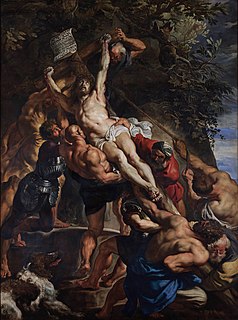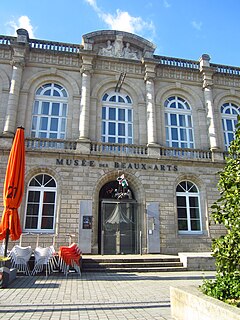
The Rijksmuseum is the national museum of the Netherlands dedicated to Dutch arts and history and is located in Amsterdam. The museum is located at the Museum Square in the borough Amsterdam South, close to the Van Gogh Museum, the Stedelijk Museum Amsterdam, and the Concertgebouw.

Karel van Mander (I) or Carel van Mander I was a Flemish painter, poet, art historian and art theoretician, who established himself in the Dutch Republic in the latter part of his life. He is mainly remembered as a biographer of Early Netherlandish painters and Northern Renaissance artists in his Schilder-boeck. As an artist and art theoretician he played a significant role in the spread and development of Northern Mannerism in the Dutch Republic.

The Bonnefanten Museum is a museum of fine art in Maastricht, Netherlands.

Koninklijke Voetbalclub Kortrijk is a Belgian professional football club based in Kortrijk, West Flanders. They play in the Belgian First Division, and they achieved their best ranking ever during the 2009–10 season, finishing fourth after the play-offs. KV Kortrijk was founded in 1971, though their roots can be traced to 1901. They are registered to the Royal Belgian Football Association with matricule number 19. The club colours are red and white. They play their home matches at the Guldensporenstadion, named after the Battle of the Golden Spurs which took place in Kortrijk in 1302.

The Royal Museum of Fine Arts Antwerp is a museum in Antwerp, Belgium, founded in 1810, houses a collection of paintings, sculptures and drawings from the fourteenth to the twentieth centuries. This collection is representative of the artistic production and the taste of art enthusiasts in Antwerp, Belgium and the Northern and Southern Netherlands since the 15th century. The museum has been closed for renovation since 2011.

The Museum of Fine Arts in Ghent, Belgium, is situated at the East side of the Citadelpark.

Jan Jacobszoon Hinlopen was a rich Dutch cloth merchant, an officer in the civic guard, a real estate developer in the Jordaan, alderman in the city council and a keen art collector. He would have been elected as a burgomaster, if he had not died at the age of forty, an age considered acceptable to be eligible. He was a prominent patron of the arts in his time, and there is some speculation on being an influential protector of Rembrandt and it is likely that he had good connections with Gabriel Metsu. Hinlopen, like his father-in-law, Joan Huydecoper I, is known in art history because of the poems by Jan Vos reciting the paintings in his house and members of the family. These paintings are spread all over the world, the poems nearly forgotten.

Flemish Baroque painting refers to the art produced in the Southern Netherlands during Spanish control in the 16th and 17th centuries. The period roughly begins when the Dutch Republic was split from the Habsburg Spain regions to the south with the Spanish recapturing of Antwerp in 1585 and goes until about 1700, when Spanish Habsburg authority ended with the death of King Charles II. Antwerp, home to the prominent artists Peter Paul Rubens, Anthony van Dyck, and Jacob Jordaens, was the artistic nexus, while other notable cities include Brussels and Ghent.

Kortrijk, sometimes known in English as Courtrai or Courtray, is a Belgian city and municipality in the Flemish province of West Flanders.

Vincent de Vos or Joost Vincent de Vos (1829–1875) was a Belgian artist who specialized in the painting of scenes with animals, in particular, monkeys, dogs and cats.

The Museum of Fine Arts is a fine arts museum in Reims, France.

The Musée Magnin is a national museum in the French city of Dijon in Burgundy, in the Côte-d'Or department, with a collection of around 2,000 works of art collected by Maurice Magnin and his sister Jeanne and bequeathed to the state in 1938 along with the hôtel Lantin, a 17th-century hôtel particulier in the old-town quarter of Dijon where it is now displayed as an amateur collector's cabinet of curiosities and as the Magnin family home.

Jan Baptiste de Jonghe or Jean-Baptiste de Jonghe was a Belgian painter, draughtsman, etcher and lithographer. He is known for his Romantic landscapes with people, herds and ruins. In his graphic work he also made views of cities in the area of what is now Belgium and the Netherlands. He was an art professor at the Academy of Kortrijk and the Antwerp Academy of Fine Arts.

Évariste Carpentier was a Belgian painter of genre scenes and animated landscapes. Over the years, his painting evolved from academic art to impressionism. Alongside Emile Claus, he is one of the earliest representatives of luminism in Belgium.

Modest Huys was a Flemish impressionist and luminist painter, who is regarded as one of the greatest Belgian painters of the 20th century.

The Musée des Beaux-Arts de Quimper is an art museum located in Quimper, Brittany, France. It was founded after Jean-Marie de Silguy (1785-1864) left a legacy of 1200 paintings and 2000 drawings to the town of Quimper on condition that the town build a museum to accommodate them. Today, it is one of the principal art museums in western France, presenting rich collections of French, Italian, Flemish, and Dutch paintings from the 14th century to present day.

Het Noordbrabants Museum is an art museum in 's-Hertogenbosch, Netherlands.

The Phoebus Foundation is an art foundation established in Jersey in 2011. It is based on Anglo-Saxon law with philanthropic objectives. The foundation acquires works of art, guarantees a professional framework of conservation and management, and looks after the conservation and restoration of the objects. In doing so, it focuses on scientific research. It shares the results of this all with the widest possible audience, through exhibitions, cultural expeditions, symposiums and publications.
Eduard Siegfried"Eddy"de Jongh is a Dutch art historian specialized in iconography. He was professor of art history with a teaching assignment in iconography at Utrecht University between 1976 and 1989.

The Maagdenhuis Museum is an art museum and historical museum located in a 17th-century historic building on Lange Gasthuisstraat, Antwerp, Belgium. The building was used as an orphanage for the maegdeckens, or maidens, from the mid-16th century to the end of the 19th century. The museum presents a collection of utensils used on a daily basis by the foundlings and the orphans; a collection of antique furniture, and a series of documents relating to the orphanage and the life in it from the 16th century to 19th century.

























